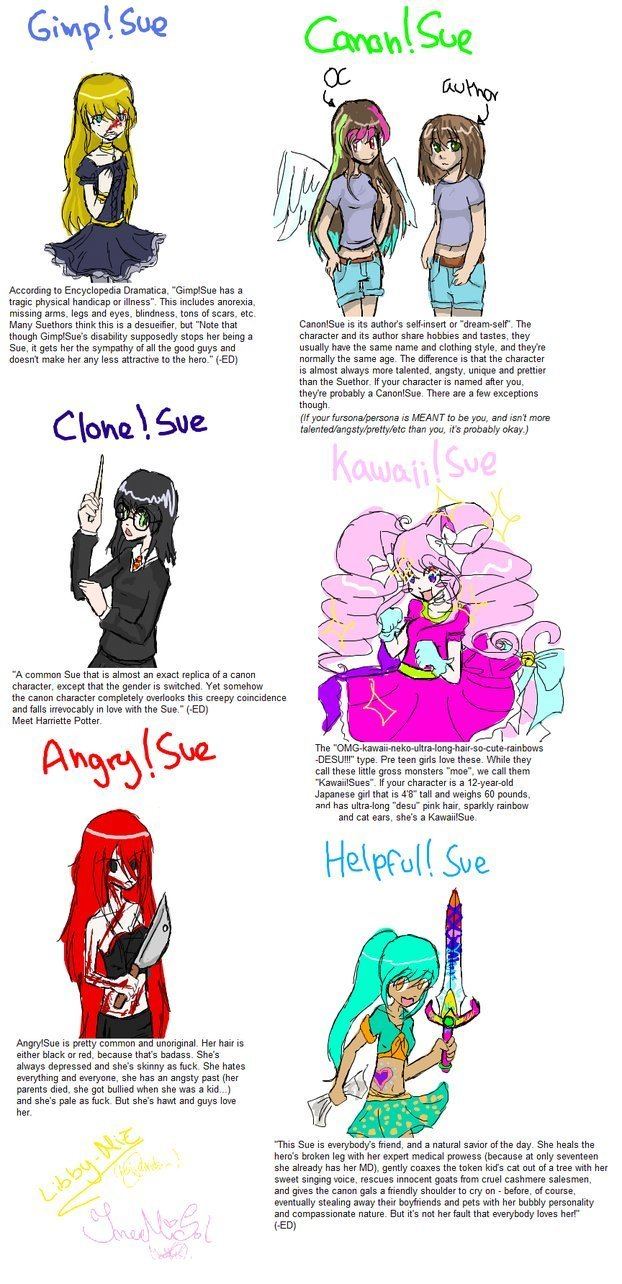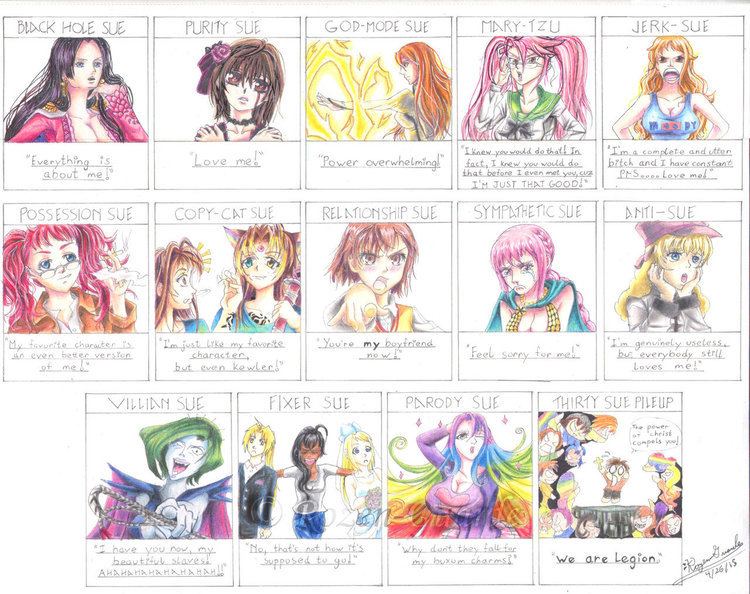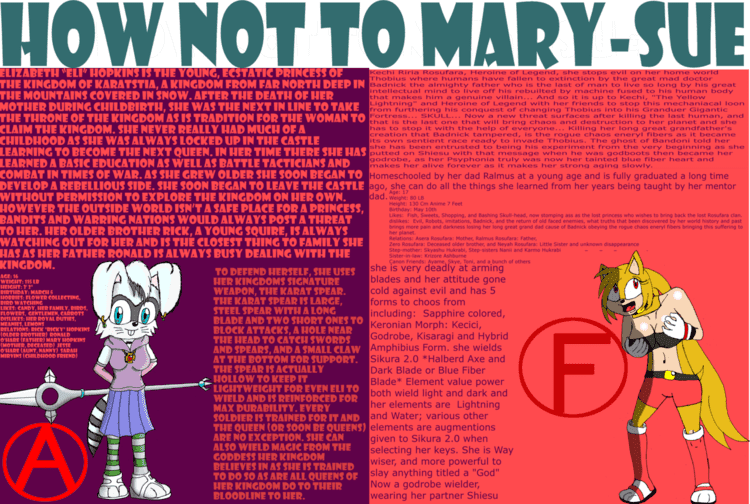 | ||
Similar Rey, Hermione Granger, Bella Swan, Kylo Ren, Slenderman | ||
A Mary Sue is an idealized and seemingly perfect fictional character, a young or low-rank person who saves the day through unrealistic abilities. Often this character is recognized as an author insert or wish-fulfillment. Sometimes the name is reserved only for women, and male Sues are called "Gary Stus," or "Marty Stus"; but more often the name is used for both sexes.
Contents

Are mary sues really bad
Origin and development of the meaning

The term "Mary Sue" comes from the name of a character created by Paula Smith in 1973 for her parody story "A Trekkie's Tale" published in her fanzine Menagerie #2. The story starred Lieutenant Mary Sue ("the youngest Lieutenant in the fleet — only fifteen and a half years old"), and satirized unrealistic characters in Star Trek fan fiction. Such characters were generally female adolescents who had romantic liaisons with established canonical adult characters, or in some cases were the younger relatives or protégées of those characters. By 1976 Menagerie's editors stated that they disliked such characters, saying:

Mary Sue stories—the adventures of the youngest and smartest ever person to graduate from the academy and ever get a commission at such a tender age. Usually characterized by unprecedented skill in everything from art to zoology, including karate and arm-wrestling. This character can also be found burrowing her way into the good graces/heart/mind of one of the Big Three [Kirk, Spock, and McCoy], if not all three at once. She saves the day by her wit and ability, and, if we are lucky, has the good grace to die at the end, being grieved by the entire ship.

"Mary Sue" today has changed from its original meaning and now carries a generalized, although not universal, connotation of wish-fulfillment and is commonly associated with self-insertion. True self-insertion is a literal and generally undisguised representation of the author; most characters described as "Mary Sues" are not, though they are often called "proxies" for the author. The negative connotation comes from this "wish-fulfillment" implication: the "Mary Sue" is judged as a poorly developed character, too perfect and lacking in realism to be interesting.
Criticism

In chapter four of her book Enterprising Women, Camille Bacon-Smith states that fear of creating a "Mary Sue" may be restricting and even silencing to some writers.

Smith quotes an issue of the Star Trek fanzine Archives as identifying "Mary Sue" paranoia as one of the sources for the lack of "believable, competent, and identifiable-with [sic] female characters." In this article, author Joanna Cantor interviews her sister Edith, also an amateur editor, who says she receives stories with cover letters apologizing for the tale as "a Mary Sue", even when the author admits she does not know what a "Mary Sue" is. According to Edith Cantor, while Paula Smith's original "Trekkie's Tale" was only ten paragraphs long, "in terms of their impact on those whom they affect, those words [Mary Sue] have got to rank right up there with the Selective Service Act." At ClipperCon 1987 (a Star Trek fan convention held yearly in Baltimore, Maryland), Smith interviewed a panel of female authors who say they do not include female characters in their stories at all. She quoted one as saying "Every time I've tried to put a woman in any story I've ever written, everyone immediately says, this is a Mary Sue." Smith also pointed out that "Participants in a panel discussion in January 1990 noted with growing dismay that any female character created within the community is damned with the term Mary Sue."
However, several other writers quoted by Smith have argued that in Star Trek as originally created, James T. Kirk is himself a "Marty Stu," and that the label seems to be used more indiscriminately on female characters who do not behave in accordance with the dominant culture's images and expectations for females as opposed to males. Author Ann C. Crispin is quoted as saying: "The term 'Mary Sue' constitutes a put-down, implying that the character so summarily dismissed is not a true character, no matter how well drawn, what sex, species, or degree of individuality."
Christine Scodari, a researcher in media studies from gender perspective, noticed a tendency within slash fandom to label major female characters (e.g. Nyota Uhura in the Star Trek 2009 film reboot) as "Mary Sues" because the slash fans "begrudged" how the development of the female character takes away screen time from slashable male characters.
Variations
Marty Stu or Gary Stu is a male variant on this trope, which shares the same wish-fulfillment aspect but tends to describe a character with traits identified as stereotypically male. The Star Trek: The Next Generation character Wesley Crusher was described, in hostile terms, as a Gary Stu by the feminist popular culture magazine Bitch. Indeed, there is speculation amongst fans and academics, mainly pejorative, that Wesley was a self-insertion character for Gene Roddenberry. Other variations include Larry Stu.
Further variant names have been suggested based on the specific personality of a Mary Sue, such as Einstein Sue (a highly intelligent character), Mary Tzu (one with unrealistically sharp tactical acumen), Jerk Sue (a short-tempered character who lashes out), or Sympathetic Sue (an angsty character who wants the reader's sympathy).
Allusions
In 2004, David Orr, in a review of online fan fiction websites FanFiction.net and Godawful Fan Fiction for The New York Times Book Review, referred to "Mary Sue" as "a ludicrously empowered author proxy".
More than one commentator has analyzed the Buffy the Vampire Slayer episode "Superstar" as being a deliberate satire of Mary Sue/Marty Stu type of stories.
There has been controversy as to whether Star Wars: The Force Awakens features a Mary Sue in its protagonist Rey. Screenwriter Max Landis has said that the character fits this description, claiming that Rey is excessively gifted at a variety of skills. Conversely, Caroline Framke of Vox contended that Rey did not fit the Mary Sue profile, stating that "Any additional skills Rey has—mechanical work, hand-to-hand combat, climbing, etc—are explained when we first meet her... If she hadn't picked up those skills, she'd probably be dead". Other writers such as Tasha Robinson of The Verge have defended the idea of Rey being a Mary Sue, stating that "for women who've felt underrepresented through decades where most of the ladies onscreen were victims, tokens, rewards, or shrews, it's natural to feel a sugar rush of fulfillment over characters like Katniss Everdeen and Imperator Furiosa". Erik Kain in Forbes magazine defines Mary Sue and argues that Rey's abilities do not make her one, given the details of her established backstory.
